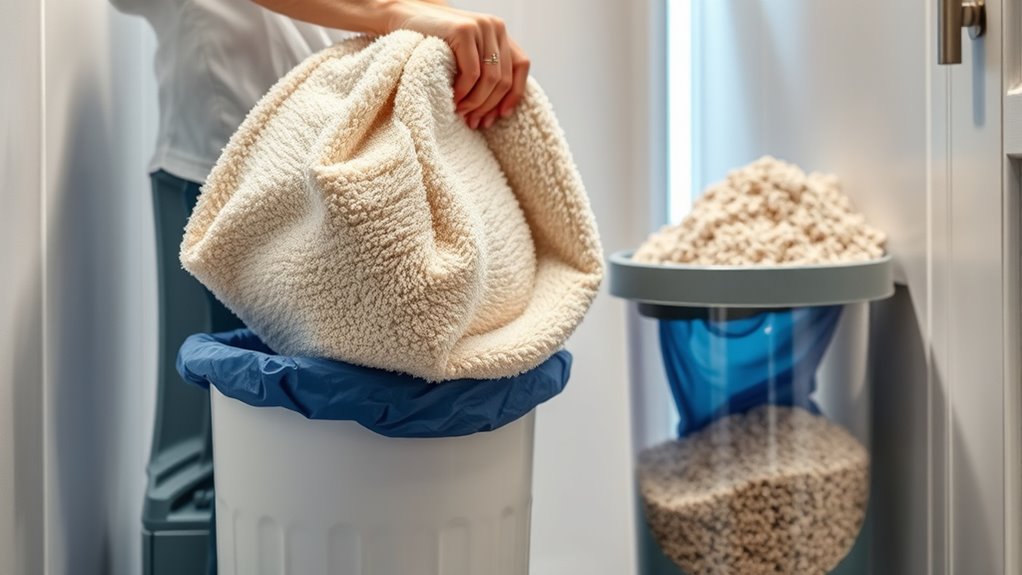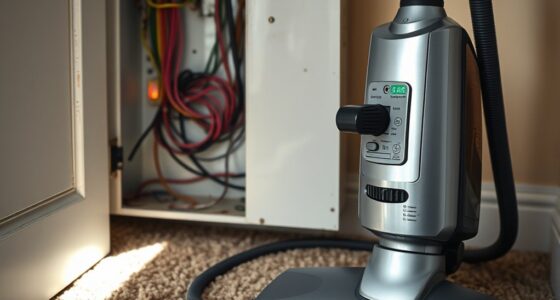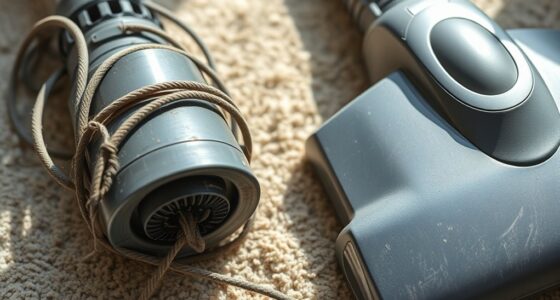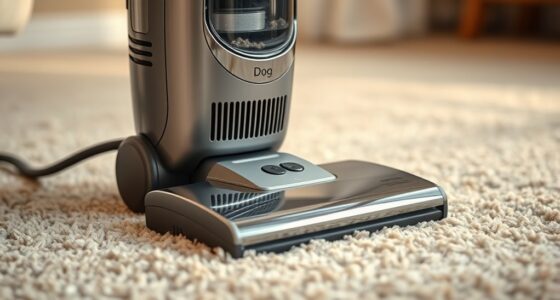To keep your vacuum working efficiently, empty bags when they’re about three-quarters full and dustbins at around 75% capacity. Don’t wait until they’re overflowing, as blocked airflow reduces suction and can damage the vacuum motor. Regular maintenance helps maintain peak performance and prolongs its lifespan. For best results, clean filters and hoses periodically and use manufacturer-recommended parts. Want to know more tips for ideal vacuum care? Keep going for detailed advice.
Key Takeaways
- Empty vacuum bags when they are about three-quarters full to maintain optimal suction and prevent motor strain.
- Dispose of dustbin contents when approximately 75% full to ensure proper airflow and prevent clogs.
- Regularly check and clean filters and hoses to avoid performance issues and prolong the vacuum’s lifespan.
- Use manufacturer-recommended bags and parts to ensure proper fit and maximum efficiency.
- Clean dustbins with mild soap and water, and allow complete drying before reassembly to prevent dust escape.

Have you ever wondered when to empty your vacuum bags or dustbins for ideal performance? Knowing the right timing can make a big difference in how well your vacuum cleans and how long it lasts. When it comes to vacuum bags, understanding the vacuum bag lifespan is essential. Most manufacturers recommend replacing the bag once it’s about three-quarters full. Waiting until the bag is completely full can reduce suction power, making your vacuum less effective and putting extra strain on the motor. If you notice your vacuum isn’t picking up debris as efficiently, it’s probably time to check the bag. Regularly monitoring the vacuum bag lifespan helps prevent clogs and maintains suction, ultimately prolonging your vacuum’s lifespan.
For dustbins, establishing a consistent dustbin maintenance schedule is just as important. You should aim to empty the dustbin as soon as it’s about 75% full. Don’t wait until it’s overflowing, as this can hinder airflow and cause dust to escape back into the air, which is especially problematic if you have allergies or respiratory issues. It’s a good idea to get into the habit of checking your dustbin after every few cleaning sessions. By doing so, you keep your vacuum operating at peak performance and reduce the risk of damage to the motor or filters. Depending on your household, especially if you have pets or lots of debris, you might need to clean the dustbin more frequently.
Additionally, understanding the importance of consistent messaging and proper maintenance can significantly impact your vacuum’s longevity and performance. In addition to timing, proper maintenance tips can help extend the life of your vacuum. Always dispose of the vacuum bag or dustbin contents carefully to avoid spreading dust and allergens. Use a damp cloth or a soft brush to clean the dustbin and check for any blockages in the filter or hose. When replacing the vacuum bag, make sure to use the correct size and type recommended by the manufacturer. This ensures a proper fit and maximum performance. For dustbins, consider washing the bin with mild soap and water periodically, but make sure it’s completely dry before reassembling to prevent mold growth.
Frequently Asked Questions
Can Overfilling Vacuum Bags Reduce Suction Power?
Yes, overfilling vacuum bags can reduce suction power. When you ignore the vacuum bag lifespan and keep it too full, airflow gets restricted, making it harder for your vacuum to work efficiently. To maintain ideal bag capacity, you should empty or replace the bag before it reaches maximum capacity. Doing this ensures your vacuum maintains strong suction, improves cleaning performance, and prolongs the lifespan of your appliance.
How Do I Prevent Dustbin Odors After Emptying?
Imagine your dustbin as a tiny monster needing fresh breath. To prevent odors, you should place air fresheners near the bin or inside the lid. Additionally, use odor absorber techniques like sprinkling baking soda at the bottom before sealing it. Regularly empty and clean your dustbin, and consider using charcoal filters for extra freshness. These simple steps keep your space smelling clean and inviting after every emptying.
Are There Eco-Friendly Options for Vacuum Bag Disposal?
You can choose eco-friendly options like biodegradable vacuum bags and reusable dustbin liners. Biodegradable vacuum bags break down naturally, reducing landfill waste, while reusable liners can be cleaned and used again, cutting down on single-use plastics. By switching to these sustainable alternatives, you help safeguard the environment and reduce your carbon footprint. Always look for products labeled as eco-friendly or biodegradable to guarantee you’re making the most environmentally conscious choice.
How Often Should I Replace Vacuum Filters?
You should replace your vacuum filter every 3 to 6 months, depending on usage and filter type. Check your vacuum’s manual for the specific vacuum filter lifespan and follow the filter replacement tips to maintain suction power and air quality. Regularly inspecting and replacing filters guarantees your vacuum runs efficiently, prolongs its lifespan, and keeps your home clean and healthy.
What Are Signs My Vacuum Needs Maintenance Beyond Emptying?
If your vacuum struggles to pick up dirt, smells burnt, or makes unusual noises, it needs maintenance beyond emptying. Check for vacuum belt issues, which can cause poor suction or strange sounds, and look for motor overheating, indicating it’s overworking. Regularly inspect and replace worn belts, clean vents, and confirm the motor isn’t overheating to keep your vacuum running smoothly.
Conclusion
Remember to empty your vacuum bags and dustbins regularly, don’t wait until they’re overflowing, and keep your space clean and fresh. Stay consistent, stay proactive, and stay healthy by maintaining your vacuum. When you empty the dustbin, you prevent clogs; when you replace the bag, you preserve suction power; when you clean the filters, you extend your vacuum’s life. Keep up with these habits, and enjoy a cleaner home with less hassle and more satisfaction.









